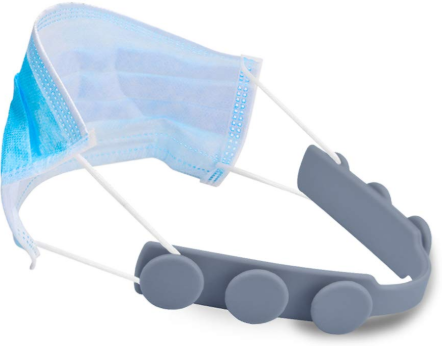Some people find that their skin beneath their face mask can become irritated or that their skin condition has flared as a result of wearing their mask. Below is a handy guide on face masks and your skin – how to wear them, remove them, wash them, picking one that suits you, and how to look after your skin.
What is the advice on face coverings?
COVID-19 spreads mainly from person to person through respiratory droplets produced when an infected person coughs, sneezes, talks, shouts or sings. These droplets can be inhaled through the nose or mouth of people who are close by. A face covering can reduce this risk of spread.
Now you have to wear a face covering in most indoor settings and crowded outdoor spaces where social distancing is difficult.
Masks play a vital role in reducing the spread of the coronavirus. However, masks can be hard on your skin, causing problems that range from acne, peeling skin, rashes, itchiness and inflammation.
It’s important that masks are a snug and comfortable fit. If the mask is too tight or moves around on your face, it can irritate your skin. Also, you will be more inclined to frequently adjust a badly fitting mask. When you touch your mask, you can transfer germs to your hands, and then to anything that you touch with contaminated hands.
How to put on a face mask
- Wash hands with soap and water or a hand sanitiser before putting on a mask
- Make sure the face mask is positioned correctly. Covering the nose and mouth, extending to under the chin, and secured around the ears, or the back of the head
- Face masks should fit correctly without gaps at the side of the face
- Face masks should allow unrestricted breathing.
Tips when wearing a mask
- The mask should not be left sitting under the nose or mouth.
- Avoid touching the front of the mask.
- If you touch the mask, wash or sanitise hands.
- If you need to reposition or adjust the mask, wash hands first, then make alterations and wash hands again.
- Remove and replace damp masks.
How to remove a face mask
- Wash or sanitise hands before removing the mask
- Remove the mask by the elastic ear loops or string ties
- Do not touch the front of the mask (it may be contaminated)
- Be careful not to touch your eyes, nose and mouth when removing the mask
- Wash or sanitise hands after removing mask.
Tips when choosing a mask
- Avoid synthetic materials, such as nylon or polyester that trap moisture. Trapped moisture can irritate the skin and also can reduce the effectiveness of the mask.
- Cotton and silk are natural fabrics that are breathable and trap less moisture. Masks should have multiple layers to act as an effective filter.
- Choose a selection of masks. Wearing loops around the ears can irritate the ears, so you may want to have some masks with loops and others with ties. If wearing for long periods and the loops are irritating the ears you can try using an Ear Saver. Ear Savers take pressure off the ears, prevent rubbing from the elastic which can occur when wearing a mask for an extended period of time or for those with more delicate skin. There are various types available through charities and online.

Skin problems linked with wearing a mask
The skin is normally home to millions of bacteria and fungi that have important roles in protection against invading microorganisms. In circumstances where the barrier is broken or when the balance between the bacteria and fungus is disturbed, skin problems can result. Masks can contribute to this imbalance.
Under the mask, the combination of trapped breath, sweat and oil leads to a warm, moist environment can lead to heat rash, acne flare-ups, trigger or worsen rosacea, perioral dermatitis, and seborrheic dermatitis.
Tight fitting medical masks can cause irritation, bruising and abrasions on the nasal bridge, behind the ear and under the chin.
Allergies may be linked to irritation from some components of some masks.
Lips may become dry when wearing a mask.
Skincare tips
- Use a gentle, fragrance-free, cleansing wash to remove sweat, dead cells and oils from the face.
- Avoid heavy moisturiser and choose a non-comedogenic moisturiser, to use under the mask. Non-comedogenic means that it will not block or clog pores
- Beneath a mask makeup is more likely to clog pores and lead to acne breakouts. This is now commonly being referred to as “Maskne”. If you do not feel you can leave off your makeup, use a non-comedogenic or oil-free make-up.
- Wash masks after use. Use a gentle detergent that will not irritate the skin, and do not use bleach on your mask. Washing removes sweat, dead skin cells and residue of skin care products.
- Moisturise your lips using Vaseline or a lip balm to prevent drying and chapping of the lips
- Take a break from the mask every 4 hours. If you’re wearing a mask for prolonged periods, if possible, try to take a break after 3-4 hours. When it is safe to remove the mask, give your skin a 15-minute break from friction and sweating and allow the skin to cool.
- Do not forget to protect your skin from the sun! Always reapply sunscreen after removing mask. The mask will rub off some of your sun protection, so make sure to reapply your SPF if you’re going out to the garden or taking a break outside without a mask.
- If your skin problems persists, always consult with your GP. You may need an active, prescribed treatment that contains a mild steroid, antibiotic or anti-fungal.
The most up-to-date guidance on face coverings is available on the HSE website.
General guidance for people with skin conditions
The ISF operates an ‘Ask a Nurse’ Helpline service where our dermatology nurses provide support, information and general guidance for your skin condition. Submit your question any time by filling out the ‘Ask a Nurse’ form.
The ISF and other dermatology organisations have been working to provide the below up-to-date guidance for people with skin conditions during this rapidly evolving situation. The ISF will ensure this content is regularly updated.
- Covid-19 and Skin Conditions – Expert Q&A
- Updated frequent hand washing advice – BAD statement
- COVID-19 Hand Care Advice
- Back to school: Tips to help you care for your child’s hands













